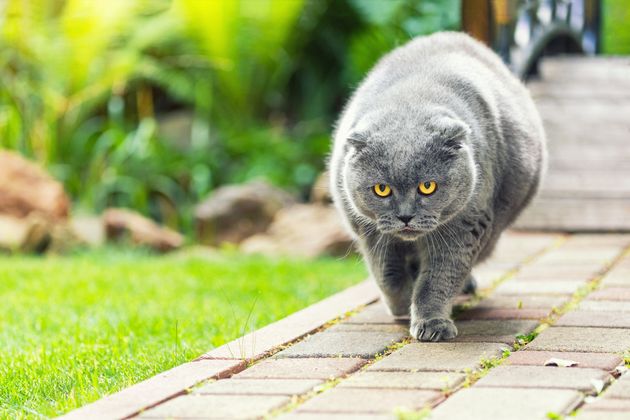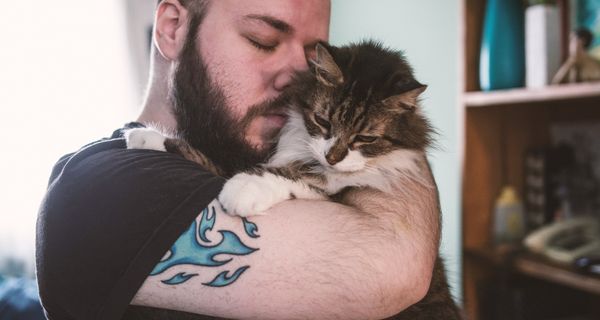Pet obesity is becoming a bit of a problem in the UK. Animal charity PDSA found 34% of cats seen by vets each week are believed to be overweight or obese.
Obesity can not only lead to mobility issues but to other health problems such as diabetes, heart disease, respiratory distress and cancer, which can all affect the quality and length of your pet’s life.
Being overweight can also put male moggies at risk of urinary issues, including urinary blockage, which can become an emergency situation.
While dogs are a little easier to control in terms of what they eat, plenty of cat owners will struggle with the fact their pet is probably getting fed elsewhere, on top of what they eat at home.
“Several studies following the movements of cats using GPS trackers have shown that some cats will regularly visit neighbouring properties,” says a spokesperson for Cats Protection. “Cats are motivated to leave their home by either food or sex, and as most of our household cats are neutered, the main motivator for them to explore the neighbour’s house is food!”
Sheena Wilson, from Exmouth in Devon, has been struggling with this problem – and recently took to Facebook to plead her neighbours to stop feeding her British Blue shorthair, Iris.
Despite her grey moggy being on a strict calorie-controlled diet, Iris is still piling on the pounds – and Wilson suspects her neighbours may be to blame. In fact, her cat is getting so big she can no longer fit through the cat flap. Wilson told The Metro: “During the last lockdown I realised that somebody else was feeding her because she was hardly eating her own food but still putting on weight.”
Animal welfare charities and vets are in agreement that neighbours should stop feeding cats, however friendly either party is. “We would discourage people from feeding other people’s cats, unless it is particularly underweight, as it will encourage them to come back,” says a Cats Protection spokesperson. If you suspect a cat doesn’t have an owner, you can contact the charity for advice.

Daniella Dos Santos from the British Veterinary Association agrees. “I would advise people to not feed neighbour’s cats,” says Dos Santos, senior vice president of the association and also a small pets vet. “There are various reasons for this. Of course, we’re talking about obesity, and that could be exacerbating the situation. But also the pet may have a medical condition that means they need to be fed specific food at specific times.”
Cats who are diabetic, have thyroid disease or are prone to urinary problems may be on specialist diets – so feeding them is putting their health at risk. “I would recommend for people to avoid feeding cats that aren’t their own,” she adds.
What to do if your cat is being fed elsewhere
Cat owners concerned their pet is being fed elsewhere can pop a paper collar on their pet asking neighbours not to feed it. Another solution, says PDSA vet Anna Ewers Clark, is to ask neighbours if your cat visits them regularly.
“It can be really interesting to find out how your cat is spending their time and it will help you keep track of how much food they’re eating elsewhere,” she says.
“If you’re struggling with your cat’s weight or aren’t able to find out where they’re going by asking around, consider getting a GPS tracker that attaches to your cat’s collar to find out where your cat spends their time.”
You could also put some friendly notes through neighbours’ doors, or flyers on local lampposts, so people are aware their kindness could lead to problems for your cat, she says.
How much should your cat weigh?
Focusing on weight is not helpful when determining obesity in cats, says Dos Santos, as different breeds can be bigger or smaller. It’s more useful for cat owners to consider their pet’s general body condition to get a sense of whether they’re getting unhealthy. Royal Canin has a useful chart that can help.
Healthy for a cat looks like this:
-
A well proportioned body
-
Ribs not visible but you can feel them
-
Obvious waist
-
Small amount of abdominal fat
-
Slight abdominal tuck
How much food should cats be fed?
It very much depends on the type of cat and how active they are. But one thing’s for sure, plenty of owners need to be cutting down.
“Pet obesity has been a huge problem in the UK for many years and sadly there is no sign of improvement, with nearly one in every two pets seen by vets and vet nurses overweight or obese. This is a serious health issue, one of the biggest currently threatening pet wellbeing across the UK,” says Ewers Clark.
“The right diet is really important for your cat and their requirements will vary depending on their age and any health problems, so we recommend feeding cats dependent on their life-stage.”
An RSPCA spokesperson tells HuffPost UK cats are usually offered two or three meals per day, but their actual preferred way of feeding is little and often. They urge people to take care with treats and tit bits – if you do give treats, keep an eye on amounts and adjust the amount of food you feed your cat accordingly.
“Cats should also have access to clean, fresh water and have opportunities for plenty of exercise to keep them happy and healthy,” they add.
If you’re unsure, speak to your vet about the optimum diet for your moggy. “The easiest way to make sure your cat is getting all the nutrients they need is to feed them a good quality, complete cat food,” Ewers Clark continues.
“Always follow the feeding guidelines which will be on the packet to ensure they are being fed the right amount.”
Ultimately, pet obesity probably isn’t caused by overzealous neighbours, says Daniella Dos Santos. “In practice it’s probably overwhelmingly from being overfed at home, where owners are just simply not aware their pets are obese or that they’re feeding them too much. Yes, neighbours feeding pets can be a problem, but more often than not the problem starts in the home environment.”




